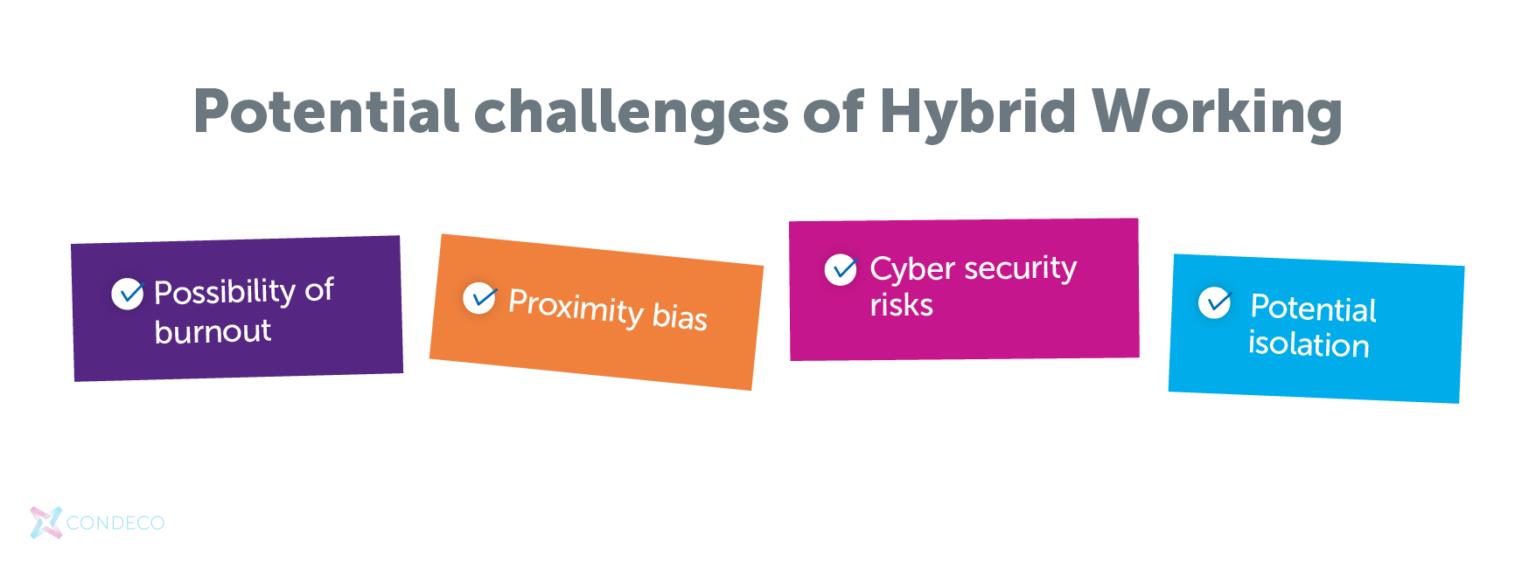
As organizations leap into the hybrid work environment, they are blending the best of in-office hustle with remote work flexibility.
How exciting is that?
However, this shift isn’t without its hurdles. Navigating the complexity of hybrid work requires a keen understanding of various challenges, from juggling communication and collaboration to maintaining a vibrant workplace culture.
But fear not, as we dive into these challenges, we’ll also uncover fail-proof solutions to conquer them and make your hybrid work model a roaring success.
So, without any further delay, let's get started!
8 Effective Solutions for Overcoming Hybrid Work Challenges
Let’s get to know some of the effective fail-proof solutions to make your hybrid work culture a success!

1. Communication and Collaboration
In the vibrant world of hybrid work, keeping communication lines clear is essential! Ensure your team is always on the same page by establishing explicit communication protocols. These should define expectations for response times and outline preferred modes of communication.
By setting these guidelines, you create a structure that supports both in-person and virtual team members, making real-time collaboration feel seamless and inclusive. Plus, regular training sessions on how to interpret digital cues can empower employees to master the art of virtual communication!
Who said team building is only for in-office days? Think outside the box and host hybrid team-building activities that bring remote and in-office staff together for fun and camaraderie!
Engage your team in virtual games, happy hours, or problem-solving exercises that promote social interaction. These activities help build strong bonds and boost morale, ensuring every team member feels like they’re part of the work-family, regardless of their location.
2. Employee Onboarding
Supercharge your onboarding experience by embracing advanced onboarding software! These digital platforms facilitate seamless remote orientation sessions, ensuring new hires feel welcomed from day one. Virtual tools make it easy to conduct training modules and orientation meetings, allowing new team members to integrate smoothly into your hybrid workforce and hit the ground running.
The hybrid employee experience only gets better when mentorship programs are involved! Assign mentors or buddy systems to new hires for personalized guidance and support. This ensures that newcomers have a go-to person for questions, helping them navigate company culture and connect with team members. It fosters a sense of belonging and aids in transferring essential information without the need for physical presence.
Detailed documentation is the backbone of a successful hybrid onboarding process. Craft clear and comprehensive documents outlining company policies, procedures, and resources. Make these accessible online so remote hires can easily refer to them. Well-organized documentation provides clarity and saves time, allowing new employees to focus more on contributing to their roles and less on guesswork.
Do you follow us on Social Media? We regularly share upgraded educational content, tips, feedback, and more. Check us out by clicking the profiles here - Facebook / Twitter / LinkedIn / Pinterest / Instagram / YouTube
3. Workplace Culture
In the evolving landscape of hybrid work, building a strong workplace culture is pivotal. But how do you cultivate connections when half the team is remote? The answer is simple! Encourage virtual social interactions. These casual check-ins or virtual coffee chats can recreate the spontaneous office conversations we all miss.
It's not only about work but forming bonds, ensuring everyone feels included and valued, no matter where they are. Spontaneous and unplanned interactions can foster serendipity, leading to fresh ideas and stronger collaboration.
Diversity and inclusion cannot take a back seat in a hybrid setup. Establishing virtual Employee Resource Groups (ERGs) focused on shared interests, diversity, or professional growth is vital. ERGs create a sense of community and belonging, even when teams are dispersed.
They act as a support network, promoting inclusivity, understanding, and a shared purpose. In turn, this ramps up morale, and employees feel represented, heard, and valued. An absolute win for everyone involved!
Fostering a culture of growth is crucial! Providing continuous learning opportunities through virtual workshops, webinars, and skill-building sessions keeps everyone on the innovation track. Employees can expand their knowledge base, improve their skills, and stay engaged.
This not only amplifies their individual potential but also strengthens the team as a whole. Learning is a lifelong journey, and in a hybrid work world, it becomes even more exciting and accessible!
4. Inclusive Meetings
Your workers may get tired of waking up at odd hours for meetings. However, you can make their life simple by embracing flexible scheduling. Accommodating different time zones and rotating meeting times ensure nobody is left consistently inconvenienced. This sensitivity fosters a collaborative environment where all contributions are equally valued. Flexible scheduling is key to engaging every team member and creating a seamless meeting experience.
Break free from one-sided meetings by employing interactive collaboration tools! Tools that enable real-time contributions from both in-person and remote participants level the playing field. Think of shared documents, digital whiteboards, and instant polls, all allowing everyone to actively engage, share ideas, and contribute to discussions. These tools can transform meetings into a dynamic, inclusive, and productive experience everyone looks forward to.
If any workers have missed a meeting, then no worries! Recording and sharing meeting content ensures everyone stays in the loop, regardless of their schedule. This practice is a game-changer, especially for those across varying time zones.
Meeting recordings, coupled with a summary of critical points, allow team members to catch up at their convenience, contributing to an inclusive and informed workforce. It’s all about making sure that every voice is heard and no one feels left behind.
5. Scheduling Work Arrangements
Meet the superhero of hybrid work scheduling: Hybrid Work Planning Tools! These tech-savvy platforms simplify the complexity of hybrid schedules. With intuitive calendars, you can hit that sweet spot of managing flexible work arrangements while maintaining employee independence.
Define work-from-home thresholds, align with occupancy parameters, and keep scheduling transparent across the company. It's the sure way to escape the chaos of spreadsheets and manual tools.
Flexibility is the golden ticket to hybrid work harmony. By allowing employees to customize their schedules, you foster a sense of autonomy and responsiveness. Encourage open communication about schedules, and keep visibility high. Everyone should know who's where and when ensuring seamless collaboration and an agile hybrid workplace.
6. Office Space Management
Say goodbye to dedicated desks and hello to Hot Desking Systems. This approach maximizes space utilization by giving employees the freedom to choose their desks based on daily needs. It’s a lively, collaborative solution that accommodates the whimsical nature of hybrid schedules, ensuring efficiency without the empty-seat syndrome.
Think of your office as a chameleon that adapts to the needs of the day! Design your space with flexible furniture and modular setups. This allows for quick reconfigurations based on team sizes or project demands, creating a versatile environment where productivity thrives.
Surprisingly, trimming down office space might just be the ace up your sleeve. With a portion of the workforce embracing remote work, reducing your physical footprint can lead to significant savings. Plus, a smaller space can still deliver big on collaboration and innovation when designed thoughtfully and effectively!
7. Technology Selection
In the world of hybrid work, selecting the right technology starts with truly understanding the needs of your workforce. It's crucial to ask questions like: What technology will boost productivity whether employees are in the office or working remotely?
Identifying these needs helps in choosing tools that facilitate efficient communication, collaboration, and workflow.
Once workforce needs are clear, ensuring seamless integration with existing systems is the next step. The goal is to avoid disruptions and maintain workflow continuity. Opt for technology that talks to your current tools without any hiccups! This means less training time and a smoother transition for everyone involved.
In a hybrid setup, security is a top priority. Alongside scalability, these factors ensure that your chosen technology can grow alongside your organization while keeping your data safe. Emphasize robust security features and choose platforms that can handle the dynamic nature of hybrid work.
8. Ensuring Productivity
Productivity in a hybrid work environment requires setting adaptive performance goals. These goals should be flexible enough to adjust to the fluid nature of hybrid work, enabling quick pivots and continuous improvement. Shortening performance objectives allows teams to adapt and maintain motivation.
Consistent check-ins are vital for bridging the gap between remote and in-office work. Prioritize virtual meetings, feedback sessions, and one-on-one check-ins to ensure everyone is on track and feels connected. This approach fosters communication and alignment, boosting overall productivity.
To maintain productivity, supporting skill development is a must. Encourage ongoing learning through workshops and webinars, providing employees with the tools they need to thrive in a hybrid environment. This not only boosts individual growth but also enhances team performance.
Navigating Hybrid Work Successfully
Overcoming hybrid workplace hurdles highlights the positive potential of hybrid work innovation for every business leader and their workers. With deliberate planning, adaptability, and an emphasis on genuine human engagement, these challenges can transform into stepping stones toward an exciting future of work.
So, consider enrolling yourself in courses like training strategies and solutions for companies, embrace every upcoming change with enthusiasm, and watch your hybrid workplaces thrive!
We believe education should be accessible for everyone. That’s why we don’t charge for our blogs. Find the right course that will help you in your career with us, contact us at +6621056101. You can mail us at act@asiancollegeofteachers.com
Written By : Laura Taylor
Centre For Training & Professional Development (CTPD) - The Trading brand of TTA Training Private Limited, India is a ISO 9001:2015 Company




© 2021 - Centre For Training & Professional Development (CTPD). All Rights Reserved. Centre For Training & Professional Development (CTPD) trading brand of TTA Training Pvt. Ltd (India) - CIN U80902WB2016PTC215839, Asia Teachers Training Co., Ltd (Thailand) - Registration No. 0105558193360 & Asian College Of Teachers Ltd (UK) - Company Number 9939942 & Asian College Of Teachers LLC, (USA) - Federal Tax Identification Number 30-1261596
Designed by kreativewebtech